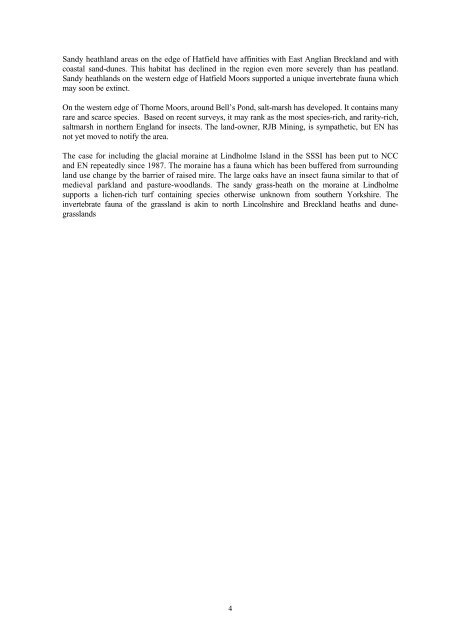free download - Thorne & Hatfield Conservation Forum
free download - Thorne & Hatfield Conservation Forum
free download - Thorne & Hatfield Conservation Forum
You also want an ePaper? Increase the reach of your titles
YUMPU automatically turns print PDFs into web optimized ePapers that Google loves.
Sandy heathland areas on the edge of <strong>Hatfield</strong> have affinities with East Anglian Breckland and with<br />
coastal sand-dunes. This habitat has declined in the region even more severely than has peatland.<br />
Sandy heathlands on the western edge of <strong>Hatfield</strong> Moors supported a unique invertebrate fauna which<br />
may soon be extinct.<br />
On the western edge of <strong>Thorne</strong> Moors, around Bell’s Pond, salt-marsh has developed. It contains many<br />
rare and scarce species. Based on recent surveys, it may rank as the most species-rich, and rarity-rich,<br />
saltmarsh in northern England for insects. The land-owner, RJB Mining, is sympathetic, but EN has<br />
not yet moved to notify the area.<br />
The case for including the glacial moraine at Lindholme Island in the SSSI has been put to NCC<br />
and EN repeatedly since 1987. The moraine has a fauna which has been buffered from surrounding<br />
land use change by the barrier of raised mire. The large oaks have an insect fauna similar to that of<br />
medieval parkland and pasture-woodlands. The sandy grass-heath on the moraine at Lindholme<br />
supports a lichen-rich turf containing species otherwise unknown from southern Yorkshire. The<br />
invertebrate fauna of the grassland is akin to north Lincolnshire and Breckland heaths and dunegrasslands<br />
4


